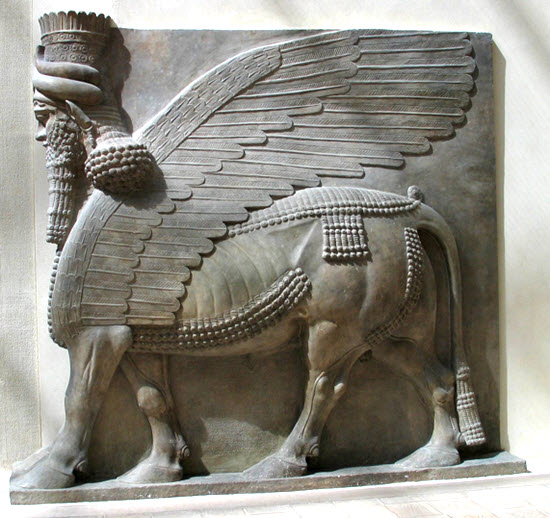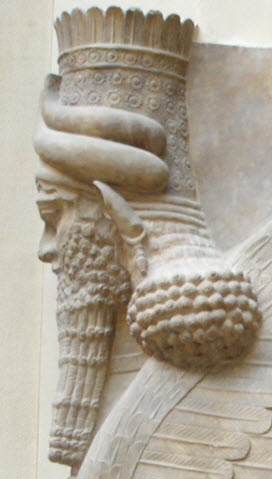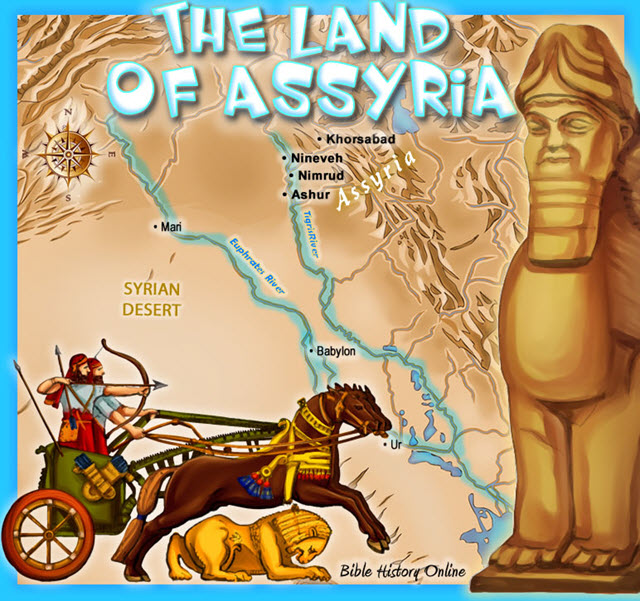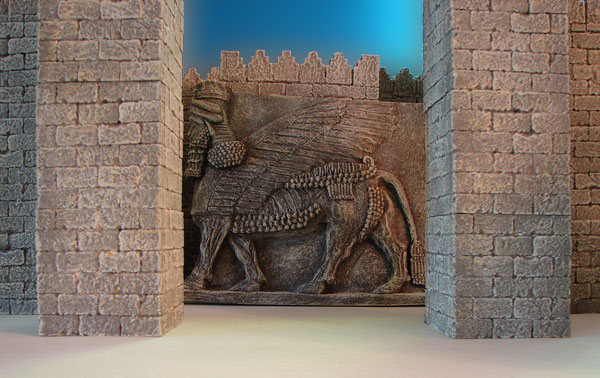|
|
|
 |
The Bible
Mentions Sargon. This colossal
winged bull guarded the throne room of king Sargon at his palace
in Khorsabad which archaeologists discovered. The Bible mentions
Sargon by name in Isaiah 20:1 |
This miniature replica is a giant Winged
Lamassu of Assyria, from the Palace of Sargon II. It was used at palace
entrances and placed strategically by magicians to protect from evil. It was discovered at the site of ancient Khorsabad
around 1843 by Paul Botta and dates to the reign of Sargon II (721-705 BC). The original is
located at the Louvre Museum in France. It is over 16 feet tall and weighs over
40 tons.
Isaiah 20:1 -
In the year that Tartan came unto Ashdod, (when Sargon the
king of Assyria sent him,) and fought against Ashdod, and took it;

This map shows the primary capitals of the Neo-Assyrian Empire
Museum Images


Information About the Colossal Stone
Bull Sculpture
- Limestone sculpture of a Colossal Bull weighing over
40
tons
- It guarded Sargon the Great's throne room
- Magicians chose their exact positions to guard against evil
- It had a human head, the body and ears of a bull, and wings of a bird
- Notice it wears the horned crown of supernatural beings
- The giant bull was carved in limestone and stands 16 feet tall
- The bull was discovered by Paul Emile Botta around 1843
- Excavated at the site of ancient Khorsabad
- Currently at the Louvre Museum in Paris, France
- From the Neo-Assyrian Period (1000-612 BC)
- It guarded the entrance to the Palace at Khorsabad (Dur Sharrukin)
- Khorsabad was Sargon's capital city (Northern Iraq)
- During the reign of King Sargon II (722-705 BC)
- The bull was a god and a symbol of royal divinity in ancient Assyria
- The bull was a symbol and power and rage in war
- The bull was used extensively to decorate palaces of the Assyrian
kings
- Colossal stone carved animals guarded the entrance of the palaces of
Assyria
- The Lamassu was later reused in Persian Achaemenid royal gates.
- King Esarhaddon said they were used to "repulse the wicked"
- This bull has 4 legs, another in the museum has 5 legs
- Two other winged bulls (over 30 tons each) were sunk by pirates
- Many other relics (over 200) were lost in the river due to pirates
Interesting Note: An Assyrian scribe claimed that
one of the reasons for the death of Sennacherib was that a Lamassu fell
on him because of his impious deeds. Sennacherib was the Assyrian king
who lost his army attacking Jerusalem, destroyed by the "Angel of the
LORD."

Museum Excerpt
Human Headed Winged
Lamassu
Khorsabad, northern Iraq
Neo-Assyrian, about 710-705 BC
Height: 4.20 meters
Length: 4.36 meters
Human-headed winged bulls were protective genies called shedu or lamassu,
and were placed as guardians at certain gates or doorways of the city
and the palace. Symbols combining man, bull, and bird, they offered
protection against enemies.
A protective genie to guard the city
When in around 713 BC Sargon II founded his capital, Dur Sharrukin,
present-day Khorsabad, he enclosed it, together with several palaces,
within a great wall of unbaked brick pierced by seven gates. Protective
genies were placed on either side of these entrances to act as
guardians. They also had a strictly architectural function, as they bore
some of the weight of the arch above. The excavations undertaken by Paul
Botta, beginning in 1843, saw the site cleared and revealed some of the
works, which were sent to the Louvre. The drawings and meticulous
surveys done then by Eugène Flandin, to be complemented a decade later
by the work of Victor Place, indicate the original position of these
winged bulls. This one formed the left jamb of Door K in the palace.
A monumental sculpture
Carved from a single block, it stands more than 4 meters high by 4
meters wide and is a meter in depth. The head is sculpted in the round,
the rest of the body in high relief. High relief was much prized in the
time of Sargon II, when modeling became more marked. The head, the only
human element, whose ears are those of a bull, has a man's bearded face
with very precisely modeled features. The eyes are expressive, the thick
eyebrows meet above a prominent nose. The kindly mouth is surmounted by
a thin mustache. A curly beard covers the jaw and chin, while the hair
falls down to the shoulders, framing the face. This human head wears a
starred tiara, flanked by pairs of horns and topped by a row of
feathers. The body, its anatomy very precisely rendered, is that of a
bull: the beast has not four but five legs, so that it looks as if
standing still when seen from the front, and as if walking when seen
from the side. From the shoulders spring the wings of a bird of prey,
only one being visible, curving above the back; broad panels of curls
cover the breast, belly, back, and rump. The tail is very long and curly
at the end. An inscription on two panels between the hind legs of the
bull praises the ruler by rehearsing his virtues and calls down a curse
on whomever should seek to harm the edifice.
These bulls are motifs of Syrian inspiration and one of the
characteristic features of the decoration of Assyrian palaces. They make
their first appearance at Nimrud in the reign of Ashurnasirpal II, to
disappear again after the reign of Ashurbanipal.
Louvre Page
Wikipedia notes: A significant number of the items
recovered by the French at Dur-Sharrukin were lost in two river shipping
incidents. In 1853, Place attempted to move two 30-ton statues and other
material to Paris from Khorsabad on a large boat and four rafts. All of
the vessels except two of the rafts were scuttled by pirates. In 1855,
Place and Jules Oppert attempted to transport the remaining finds from
Dur-Sharrukin, as well as material from other sites being worked by the
French, mainly Nimrud. Almost all of the collection, over 200 crates,
was lost in the river.[12] Surviving artifacts from this excavation were
taken to the Louvre in Paris.
 The Assyrian
Empire The Assyrian
Empire
The first great military empire in ancient history
was the Assyrian Empire. By the time of Ashurnasirpal and Shalmaneser
III in the 9th century BC the Assyrians organized a mighty army of
nearly 200,000 soldiers. Their military strategy was unsurpassed up to
that time, and with the age of iron they were an unstoppable fighting
machine. They brought spearmen, archers, shieldmen, slingers, siege
engines, chariots, and a huge calvary into the battlefield. The mighty
Assyrians dominated the ancient world until they were crippled by the
God of Israel in the reign of Sennacherib. God raised up the Assyrians
to remove Israel out of his sight for their rebellion and idolatry, but
the Assyrians would also be punished also for their wicked ways. They
finally fell to the Medes and Babylonians in 612 BC and passed into
history.
 Assyrian Kings Mentioned in the Bible
Assyrian Kings Mentioned in the Bible
2 Kings 15:29 -
In the days of Pekah king of Israel, Tiglath
Pileser king
of Assyria came and took Ijon, Abel Beth Maacah, Janoah, Kedesh, Hazor,
Gilead, and Galilee, all the land of Naphtali; and he carried them
captive to Assyria.
2 Kings 15:19 - Pul the
king of Assyria came against the land, and Menahem gave Pul one thousand
talents of silver, that his hand might be with him to confirm the
kingdom in his hand.
2 Kings 18:9 -
And it came to pass in the fourth year of king Hezekiah, which [was] the
seventh year of Hoshea son of Elah king of Israel, that Shalmaneser king
of Assyria came up against Samaria, and besieged it.
Isaiah 20:1 -
In the year that Tartan came unto Ashdod, when Sargon the
king of Assyria sent him,) and fought against Ashdod, and took it;
2 Kings 19:16 -
LORD, bow down thine ear, and hear: open, LORD, thine eyes, and see: and
hear the words of Sennacherib,
which hath sent him to reproach the living God.
2 Kings 19:37 -
And it came to pass, as he was worshipping in the house of Nisroch his
god, that Adrammelech and Sharezer his sons smote him with the sword:
and they escaped into the land of Armenia. And Esarhaddon his
son reigned in his stead.
Ezra 4:10 - and the rest
of the nations whom the great and noble Asnapper brought
over, and set in the city of Samaria, and in the rest of the country
beyond the River, and so forth, wrote.
Assyrian Kings Names in Cuneiform
Archaeology
of Ancient Assyria
Timeline of Ancient Assyrian Kings
(During the Period of the Biblical Kings)
Assur-nasirpal II (885-860
B.C.) A cruel warrior king, he made Assyria into the most fierce
fighting machine of ancient world.
Shalmaneser III (860-825
B.C.) His reign was marked by almost constant war. He was the first
Assyrian king to come into conflict with Israel. King Ahab fought
against him, and king Jehu paid him tribute in 841 BC. His royal
inscriptions were more detailed and more numerous than any other king.
His building works were massive just like his father Assurnasirpal II.
See Shalmaneser
and the Black Obelisk.
Shamsi-Adad V (825-808
B.C.) Most of his reign was focused on Babylonia and his own internal
conflicts.
Adad-nirari III (808-783
B.C.) The little information about his reign mentions his building
projects at Calah and Nineveh, as well as a conflict at Der in Babylonia
and collecting tribute in Damascus, Syria.
Shalmaneser IV (783-771
B.C.) The limited knowledge of his reign reveal some conflicts in
Damascus and a period of decline in Assyria.
Assur-dayan III (771-753
B.C.) The little information about this ruler reveals Assyria being in a
period of decline.
Assur-nirari V (753-747
B.C.) There is very little information about his reign. The king of
Urartu boasted of a victory over this king of Assyria in an inscription.
Tiglath-pileser III (Pul)
(747-727 B.C.) He restored Assyria to a major world power. He is the "Pul"
mentioned in the Bible and the one who began to destroy Samaria, the
capital of the Northern Kingdom of Israel. He carried many away into
captivity. This captivity is mentioned in his own inscriptions, the
Babylonian Chronicle, and the Bible.
Shalmaneser V (727-722
B.C.) He besieged Samaria, the capital of the Northern Kingdom of
Israel. He died during the siege after imposing taxation on the holy
city (Asshur), and his son Sargon came to power.
Sargon II (722-705
B.C.) He completed the destruction of Samaria and the captivity of
Israel. He was also famous for his magnificent palace with his colossal
winged guardians.
Sennacherib (705-681
B.C.) He was the most famous of the Assyrian kings. He mentions the name
of Hezekiah on his prism during his war campaigns, he claimed to have
"Hezekiah captured in his own royal city (Jerusalem) like a caged bird."
His army was defeated at the gates of Jerusalem by the Angel of the
Lord. Sennacherib returned back to Nineveh and was killed violently by
his own son, as mentioned in the Babylonian Chronicle, The Bible, and
various other inscriptions. He also conquered Babylon.
Esar-haddon (681-668
B.C.) He rebuilt Babylon, invaded and conquered Egypt by crossing over
the Sinai Desert with Arab camels carrying water for his army, and was
one of Assyria's greatest kings. He died fighting Egypt.
Assur-banipal (668-626
B.C.) He destroyed the Thebes in Egypt and collected a great library,
innumerable clay tablets were found.
Assur-etil-ilani (626-607
B.C.) It was under his reign that the Assyrian Empire fell.
 Assyrian
annals mention contacts with some ten Hebrew kings: Omri, Ahab, Jehu,
Menahem, Hoshea, Pekah, Uzziah, Ahaz, Hezekiah, and Manasseh. Assyrian
annals mention contacts with some ten Hebrew kings: Omri, Ahab, Jehu,
Menahem, Hoshea, Pekah, Uzziah, Ahaz, Hezekiah, and Manasseh.
In the reign of Hoshea, king of Israel, Shalmaneser, king of
Assyria, twice invaded (2 Kings 17:3,5) the kingdom that remained, and
his successor Sargon II took Samaria in 722 BC, carrying away 27,290 of
the population as he tells in his Khorsabad Annals. Later Assyrian
kings, particularly Esarhaddon (681 BC - 668 BC), completed the task.
For More Info See:
Bible History Online
Map of the Land of Assyria

Kids Bible Maps
Primary Sources for Assyrian History
The Assyrian Annals. The scribes of the chief cities of the
Assyrians wrote the accounts of the king's military campaigns on
cuneiform tablets, and clay prisms or cylinders. The accounts are very
reliable, even though the accounts do not speak negatively of the
Assyrians and are meant to glorify the king. The annals also give much
detail to geography and Chronology. It is interesting how accurate the
Assyrians were with dates, they made use of an Assyrian Kings List or
the Eponym Canon.
The Assyrian Chronicles and Eponym Canon. The Assyrian scribes
organized their national events whether military, political or religious
every regnal year. The Babylonian Chronicles were structured the same
way. Assyrian records were kept very carefully, they took their dating
and their history seriously. They attached their record of events with
the solar year and with the name of an official who was known as the
"limmu." Their was a new limmu appointed every year. They recorded
military, political and religious events in every year and made
references to eclipses. The Assyrian records are highly dependable and
allow Biblical scholars a very accurate way of dating events and
designating "eponyms" for 244 year in Hebrew history, from 892-648 BC.
The Assyrian King List.
The Assyrian King List reveals a list of the kings of ancient
Assyria in chronological order, from the 2nd millennium BC to 609 BC. It
lists the name of the king, his father's name, the length of his reign,
and some great achievements.
Assyrian Sculptures. The limestone bas-reliefs discovered
from the palace walls of major Assyrian capital cities like Nineveh
(Kuyunjik), Nimrud (Calah), Khorsabad (Dur-Sharrukin), and the bronze
bands on the Balawat Gates reveal a wealth of history. The illustrative
events were carved be professional Assyrian artists like a modern day
photographer on the scene. The carvings reveal the military might and
tactics of the Assyrians, as well as the futility of those nations that
defied their might. These sculptures are on display in museums around
the world, for example: The British Museum in London, The Louvre in
France, The Iraqi Museum, and The Oriental Institute in Chicago.
The Bible. The Old Testament records the history of the Kingdoms
of Israel and Judah, along with the battles of other nations. It
includes the fall of the 10 tribes in northern kingdom of Israel in 722
BC by the Assyrians, as well as the
fall of the southern kingdom of Judah in 586 BC by Nebuchadnezzar of
Babylon. The Bible also records miraculous events surrounding people
like Elijah, and Jonah, as well as the slaying of 185,000 Assyrians at
Jerusalem by the Angel of the LORD. The events recorded in 2 Kings
generally agree with Assyrian and Babylonian sources.
|






